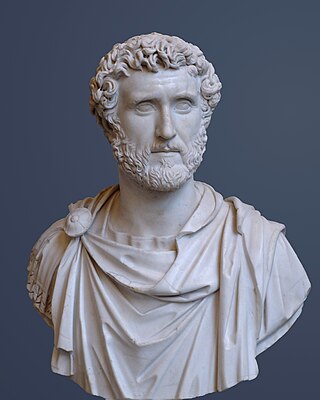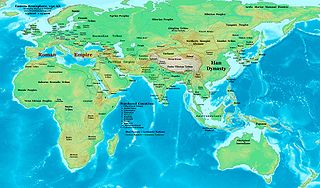This article needs additional citations for verification .(July 2016) |
| Millennium |
|---|
| 1st millennium |
| Centuries |
| Decades |
| Years |
| Categories |
The 140s decade ran from January 1, 140, to December 31, 149.
This article needs additional citations for verification .(July 2016) |
| Millennium |
|---|
| 1st millennium |
| Centuries |
| Decades |
| Years |
| Categories |
The 140s decade ran from January 1, 140, to December 31, 149.
Emperor Antoninus Pius hosts a series of grand games, to celebrate Rome's 900th anniversary. [11]
140
141
142
143
144
145
146
147
148
149
140
141
142
143
144
145
146
147
148

Titus Aelius Hadrianus Antoninus Pius was Roman emperor from 138 to 161. He was the fourth of the Five Good Emperors from the Nerva–Antonine dynasty.

The 50s decade ran from January 1, 50, to December 31, 59. It was the sixth decade in the Anno Domini/Common Era, if the nine-year period from 1 AD to 9 AD is considered as a "decade".

The 80s was a decade that ran from January 1, AD 80, to December 31, AD 89.

The 120s was a decade that ran from January 1, AD 120, to December 31, AD 129.
The 130s decade ran from January 1, 130, to December 31, 139.
The 150s decade ran from January 1, 150, to December 31, 159.
The 160s decade ran from January 1, 160, to December 31, 169.
The 170s decade ran from January 1, 170, to December 31, 179.
The 180s decade ran from January 1, 180, to December 31, 189.
The 190s decade ran from January 1, 190, to December 31, 199.
Year 138 (CXXXVIII) was a common year starting on Tuesday of the Julian calendar. At the time, it was known as the Year of the Consulship of Niger and Camerinus. The denomination 138 for this year has been used since the early medieval period, when the Anno Domini calendar era became the prevalent method in Europe for naming years.
Year 140 (CXL) was a leap year starting on Thursday of the Julian calendar. At the time, it was known as the Year of the Consulship of Hadrianus and Caesar. The denomination 140 for this year has been used since the early medieval period, when the Anno Domini calendar era became the prevalent method in Europe for naming years.
Year 141 (CXLI) was a common year starting on Saturday of the Julian calendar. At the time, it was known as the Year of the Consulship of Severus and Stloga. The denomination 141 for this year has been used since the early medieval period, when the Anno Domini calendar era became the prevalent method in Europe for naming years.
Year 145 (CXLV) was a common year starting on Thursday of the Julian calendar. At the time, it was known as the Year of the Consulship of Hadrianus and Caesar. The denomination 145 for this year has been used since the early medieval period, when the Anno Domini calendar era became the prevalent method in Europe for naming years.
Year 147 (CXLVII) was a common year starting on Saturday of the Julian calendar. At the time, it was known as the Year of the Consulship of Messalinus and Largus. The denomination 147 for this year has been used since the early medieval period, when the Anno Domini calendar era became the prevalent method in Europe for naming years.
The 220s decade ran from January 1, 220, to December 31, 229.

Annia Galeria Faustina the Elder, sometimes referred to as Faustina I or Faustina Major, was a Roman empress and wife of the Roman emperor Antoninus Pius. The emperor Marcus Aurelius was her nephew and later became her adopted son, along with Emperor Lucius Verus. She died early in the principate of Antoninus Pius, but continued to be prominently commemorated as a diva, posthumously playing a prominent symbolic role during his reign.
Ceionia Fabia was a noble Roman woman and a member of the ruling Nerva–Antonine dynasty of the Roman Empire.
Annia Fundania Faustina was a noble Roman woman who lived in the Roman Empire during the 2nd century AD. She was the paternal cousin of Roman Emperor Marcus Aurelius and his sister Annia Cornificia Faustina.

Gaius Julius Sohaemus was a Roman client king of Armenia.